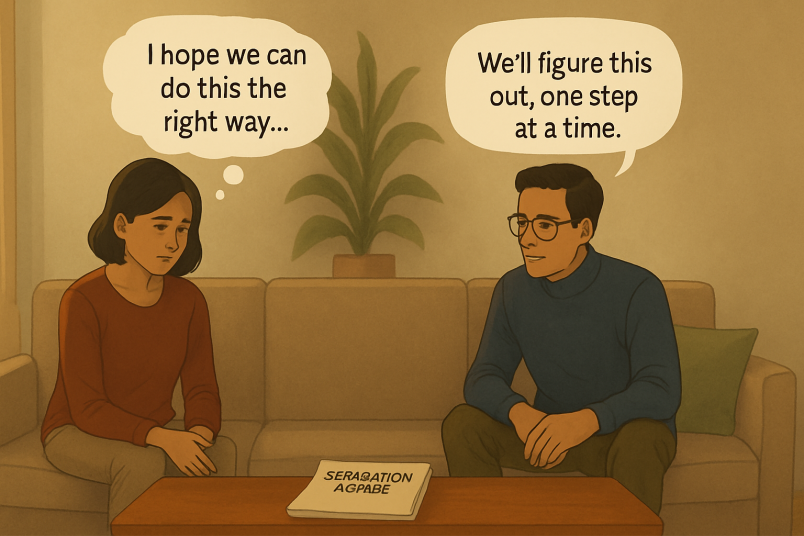How to File for Legal Separation: 7 Steps

Unlock Daily 30-Sec Tips for a Happier Relationship
👉 Subscribe FREEKey Takeaways
Marriage.com AI Quick Summary
When life feels a little heavier than usual and you’re trying to make sense of your next steps, understanding how to file for legal separation can bring a quiet kind of clarity.
Emotions, hopes, and practical decisions often blend together during times like these; it’s natural to feel unsure, scattered, or even relieved all at once.
Taking things slowly—pausing, reflecting, and choosing what feels right—can make the process feel less intimidating. And even though this moment may be tender, you’re doing your best… one thoughtful step at a time.
What is a legal separation?
A legal separation is a formal arrangement where a married couple chooses to live apart while still remaining legally married. It outlines responsibilities like finances, custody, and living arrangements, providing structure without ending the marriage.
A research paper published in 1983 states that many couples increasingly chose legal separation instead of divorce, often because it felt less final and allowed time to sort out emotional, financial, or family matters.
Example: A couple might decide to live in separate homes, share childcare schedules, and divide expenses temporarily while they figure out whether reconciliation or divorce feels right.
Please note:
And if you’re exploring how to file for legal separation, take heart—this step doesn’t have to mean the end. It can simply be a period of clarity, healing, and thoughtful decision-making. You’re allowed to take it slow.
How to file for legal separation: 7 steps
There is no law that requires a married couple to live together.
Thus, to know how to file for legal separation, there are no restrictions on the legal separation process. That said, they are still legally married and must consider how they will address such matters as property, debts, child custody and visitation, child support, spousal support, and bills.
1. Know your state’s residency requirements
You must be aware of your state’s divorce laws to know about your state’s residency requirements. For example, in certain states, at least one of the partners should reside in the state for the filing for separation. Hence, the rules are different for different states.
2. File separation papers
You begin to file for legal separation with your local family court, requesting the separation and proposing the terms. Your proposal should address child custody, visitation, alimony, child support, and the division of marital property and debts during a separation agreement.
3. Serve your spouse with legal separation papers
Unless you and your spouse file for separation jointly, you will need to be served with the legal separation documents or separation papers to become legally separated.
4. Your spouse responds
Once served, your spouse is allowed a certain amount of time to respond and let you and the court know if they agree or disagree with your proposal.
5. Settlement of issues
If your spouse responds affirmatively, you can move to the next step. However, your spouse can file a counter-petition if they have certain issues with signing the legal separation forms. This is when mediation or collaborative law will come into the scene.
6. Negotiations
Once your spouse has responded to your proposal and the two of you are in agreement on the terms of your separation, the marriage separation agreement must be put into writing, signed by both of you, and filed with the court.
If your spouse does not agree with the terms of your proposal, you can try to reach an agreement on any contested issues of fact through negotiation or mediation. If you cannot come to an agreement, your case must go to court in order to be settled by a judge.
7. The judge signs your separation judgment
Once you have come to a mutual agreement on any contested issues of fact, or a judge has decided them, the judge will sign your separation agreement, and you will be legally separated. However, you will still be married and thus will not be able to remarry.
How legal separation can help you
Legal separation can offer structure, emotional space, and practical clarity when a marriage feels uncertain. It allows couples to step back without ending the relationship, giving them time to reassess their needs.
A research paper published in ResearchGate states that marital separation can offer several benefits, including emotional relief, reduced conflict, clearer thinking, and the space needed for individuals to understand their needs and make healthier long-term decisions.
It can also help you understand how to file for legal separation or even explore how much does it cost to file for legal separation if you’re considering it.
1. It gives you emotional space
Legal separation allows both partners to step back from daily conflict and tension. This breathing room often helps people think clearly about what they want, without the pressure of living together.
It also reduces emotional intensity, which can make communication calmer and more productive. Many couples find that physical distance leads to clearer perspective. In some cases, this space becomes the starting point for healing or healthier decision-making.
- Example: One partner moves into a temporary apartment so both can reflect without constant arguments.
2. It protects your finances
A legal separation puts financial responsibilities in writing, which helps prevent confusion or unfair situations. It can outline who pays which bills, how debts are handled, and how money is managed while living apart.
This clarity reduces financial stress during an already emotional period. Courts can also protect individual assets from being spent or misused. It’s a safe way to stay legally tied while keeping finances stable.
- Example: The court orders each partner to pay specific household expenses separately to avoid disputes.
3. It supports co-parenting stability
For couples with children, legal separation creates a structured plan for custody, visitation, and decision-making. This helps kids feel more secure because routines stay predictable. Parents also get clear guidelines, which reduces conflict and misunderstanding.
A stable plan gives both partners time to adjust to new roles while focusing on their children’s well-being. The separation becomes less chaotic and more manageable.
- Example: Parents follow a weekly custody schedule that lets kids spend quality time with both.
4. It allows time for reconciliation
Some couples aren’t sure if they want to divorce, and that’s completely valid. Legal separation gives them room to evaluate their relationship without rushing. They can attend counseling, work on communication, or simply reflect individually.
A research paper titled The social process of involuntary separation and the search for connection states that separation often leads people to seek new sources of emotional support and connection, helping them rebuild a sense of identity amid change.
This process often leads to clearer answers about the future. For some, separation becomes a bridge to rebuilding trust.
- Example: A couple uses the separation period to attend therapy and rebuild healthier habits.
Watch this TED Talk by Antonio Pascual-Leone, a clinical psychologist, who shares how processing emotions in stages can help you heal after a breakup.
5. It offers structure if divorce becomes necessary
If the relationship eventually moves toward divorce, legal separation makes the transition smoother. Many of the agreements—like finances, parenting, or property responsibilities—can be carried over. This reduces stress and sometimes even speeds up the process.
It also lets each partner prepare emotionally and financially for long-term decisions. Essentially, it lowers the shock and uncertainty that divorce can bring.
- Example: The same custody arrangement from the separation is later used in the divorce settlement.
Please note:
It’s completely normal for legal separation to feel tough in the beginning—change often does. But remember, your peace sometimes comes with a cost, and it’s worth protecting. Don’t lose hope; trust yourself, take each step at your own pace, and things will eventually fall into place.
Choosing your clarity
Legal separation may feel emotionally heavy at first, but it can also be a meaningful step toward clarity, stability, and peace. Whether you’re taking time to heal, hoping to rebuild, or preparing for long-term decisions, each choice you make is part of your growth.
Understanding how to file for legal separation empowers you to move forward with confidence and structure. Be gentle with yourself, trust the process, and remember—you’re allowed to prioritize your well-being. With time, patience, and support, the path ahead becomes clearer.
 Tips
Tips
Write your tip or submit a video tip
All tips are reviewed before the publishing.
Share this article on
Want to have a happier, healthier marriage?
If you feel disconnected or frustrated about the state of your marriage but want to avoid separation and/or divorce, the marriage.com course meant for married couples is an excellent resource to help you overcome the most challenging aspects of being married.
Recent Articles
Related Quizzes
Unlock Daily 30-Sec Tips for a Happier, Healthier Relationship
👉 Subscribe FREE on YouTube We'd love your feedback!
We'd love your feedback!
 Expert Q&A
Expert Q&A
Ask your question related to this topic & get the support you deserve from experts.

 Legal Guide
Legal Guide


















 Thanks for your feedback!
Thanks for your feedback!